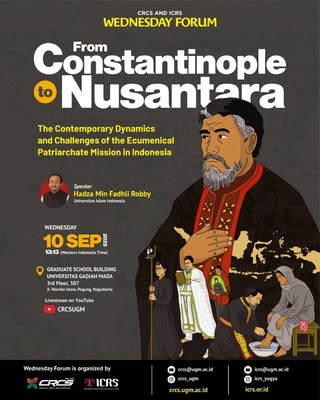
Angie W
Recently, many Indonesians were stunned by the decision of the government, in this case the President, to grant mining management permits to community and religious organizations. The Indonesian government's decision to grant mining permits to religious organizations may seem unusual, but it can be explained by a few factors related to both the legal framework and the socio-political context of Indonesia. One key point that might explain the reason behind such decision is that granting mining permits to a religious organization, especially Islamic groups, in an area where they exert considerable influence may be a way to conciliate powerful leaders and maintain political stability. There is a lot of criticism directed at religious organisations that have expressed their willingness to manage mines. However, the religious group's justification is that they are motivated to manage the mine in an environmentally friendly manner which they refer to as ‘green mining.’
Eko Cahyono from the Sajogyo Institute, who gave a presentation for NICMCR, said that the term green mining sounded very funny and alarming. In his presentation entitled Double Face of Religion and Ecological Crisis, he tried to point out a unique fact in Indonesia, namely that sometimes religions play an advocacy role for environmental conservation but at the same time become a legitimator for environmental destruction. The multidimensional impact of mining damage (mafsadat) has been clearly empirical, while its goodness (maslahat) is still speculative. Religion would become an instrument, political commodity, and a mask to justify and legitimize the political interests of the elite power of religious mass organizations that have an affair with the state (power). Because, by choosing to manage mining, religious mass organizations enter the “power trap.” If religious mass organizations are unable to manage better than mining companies in general, then the risk of losing their own people’s trust and moral or ethical legitimacy is too great.
In a research study on the theme of Religion and Development conducted by the Sajogyo institute and CRCS UGM during 2019 to 2020, Cahyono and his team, among others, tried to find answers to the questions, where is the position of religion amidst the ecological crisis? Their research on ten cases of the intersection of religion and ecological crisis shows that religions showed two different and contradictory faces. Some of the important points found from this research are, among others, the existence of practices of instrumentalization, politicization and commodification of religion for pragmatic political power purposes, the monopoly and reduction of interpretation of religious scriptures for personal and group purposes, and, the occurrence of the “Holy-Grabbing” phenomenon which appeared from the deprivation of people’s living space with the legitimacy of holiness. The double face attitude is not something that is unique and specific to a particular religion, as it can occur in all major religions and religious beliefs. All religious communities in Indonesia, whether fundamentalist, liberal, or moderate group, have these two-faced elements. This is due to the differences each of them has in theological interpretation and the process of meaning-making. Besides, the reason was also on how they use the legitimation or politization of religion, and, on how they maintain a relationship with the capital or business owner.
Islam and Christianity in Indonesia provide some of the most prominent examples of this so-called two-facedness. Looking first at the Christian context; in Ruteng, East Nusa Tenggara, in 2015, the Catholic church rejected mining for the reason that it would be a threat to the lives of all God’s creation. However, the Catholic church in Papua accepted palm oil plantations for them to improve the welfare and lives of the congregation. Interestingly, there are different attitudes in Islam. Muhammadiyah has declared a constitutional Jihad for the Water Resource Law. Nahdlatul Ulama in Banten Province rejects water mining because that water belongs to the public, and that water mining destroys holy sites. At the same time however, Nahdlatul Ulama and Islamic boarding school in Rembang Central Java supports mining because the factory belongs to BUMN or the state and loving the nation/the state is a part of Islamic faith (hubbul wathan minal iman). Additionally, there is a case wherein Jemaah Islamiyah in Sumatera and Kalimantan manage palm oil plantations which destroy the ecosystem of the forest to finance terrorism plans.
By looking at Charles Kimball’s theory, this research argued that religions have always had two different faces and several diverse attitudes, especially in their views and attitudes towards the universe and the ongoing environmental crisis. Sometimes religion can be a grace, but sometimes, it is the cause of a disaster. Religion can become a grace if it avoids efforts to the monopoly of truth’s interpretation, does not let itself be politicized or instrumentalized for the power and pragmatic interests of another group or institution, takes the initiative to be a source of energy for the liberation of marginalized people, has a socialistic character that is opposed to exploitation and accumulation, and upholds the principles of justice and humanity (Syed H. Alatas, Islam and Socialism, 2022). At the same time, religion can be a disaster if there is a deterioration of religious values by making absolute theological interpretation (of the holy book or religious teaching) or if it is impoverished through the practices of politization, commodification, and instrumentalization of religion. As religious groups increasingly recognize their responsibility in addressing environmental issues, they must face the challenge of overcoming the contradictions within their teachings and practices.









